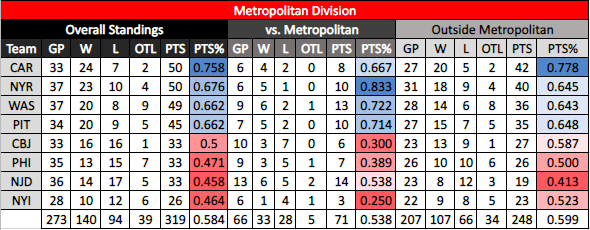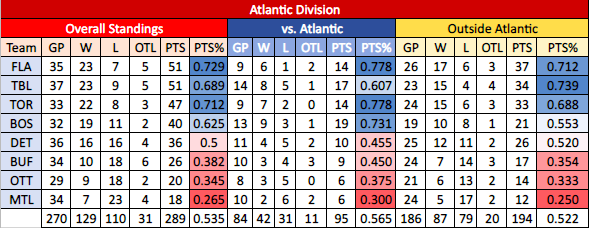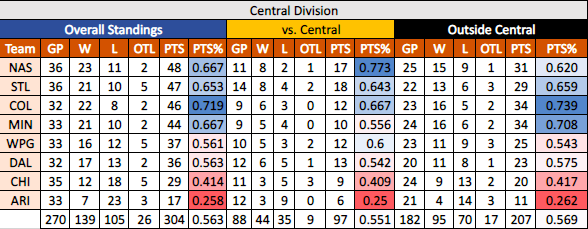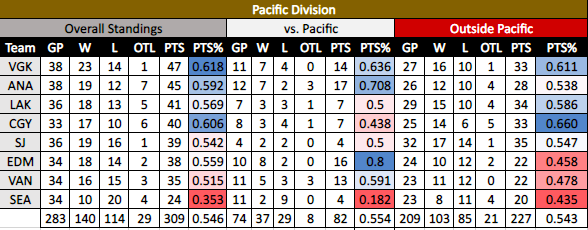A major storyline in last year’s COVID-shortened 2020-21 NHL season was the realignment that saw teams face only their divisional counterparts during the regular season. As a result, evaluating the relative strength of each franchise became more difficult as a less diverse sample of games muddied the waters. Presumed Stanley Cup contenders such as the Colorado Avalanche and Vegas Golden Knights were disregarded for beating up on “weaker” opposition. At the same time, the members of the all-Canadian North Division were derided as the league’s pitiful castaways. Yet, the Montreal Canadiens surprisingly grabbed the North’s ticket into the postseason’s final four, directly challenging the feeble identity collectively assigned to the northern contingent.
In 2021-22, the NHL reverted to its pre-COVID alignment, and schedules now list inter-divisional (outside the division) foes once more. Since every team has played through at least a third of the 82-game schedule, a somewhat reliable sample has built up. We can begin to parse how every division stands in terms of inter and intra-divisional (within the division) play. With a nod to Jeff Veillette’s Tweet for the inspiration, let’s dig into which division is the NHL’s strongest thus far and which team’s are benefitting the most, and least, from their divisional placement. I apologize in advance for my questionable aesthetic choices.
The Metropolitan Division is the NHL’s Toughest
The Metropolitan, led by the Carolina Hurricanes, first in the NHL in point percentage (PTS%), New York Rangers (sixth), Washington Capitals (ninth), and Pittsburgh Penguins (10th), boasts the highest number of top 10 squads. Surprisingly, the bottom-placed teams in the Philadelphia Flyers (24th), New York Islanders (25th), and New Jersey Devils (26th) land outside the bottom five, despite playing in the NHL’s toughest division.

The Metropolitan Division collectively ranks first in overall PTS% (58.4%), but they accumulate the lowest share of PTS% in intra-divisional matchups (53.8%). The difference is a tell-tale sign of the division’s actual strength, as the Metropolitan franchises rank first in the percentage of points collected outside of their division (59.9%).
The Hurricanes lead the Metropolitan for now but have played the joint-fewest intra-divisional games (six) among their counterparts. They’ve dominated against the more vulnerable offerings from other divisions, but they could be an underrated beneficiary of unbalanced scheduling.

Among the main Stanley Cup contenders, the Rangers, Capitals, and Penguins have surprisingly found success within the Metropolitan, an impressive feat when considering the number of formidable squads housed within that geographic area. So, that’s one half of the Eastern Conference looked at, how does the other half fare?
The Atlantic Division Ranks Last Overall
In terms of the overall standings, the team’s within the NHL’s Atlantic Division sit dead-last in terms of PTS%, only collecting a point in 53.5% of possible games. They owe that miserable honor to the woeful triumvirate of the Buffalo Sabres (38.2%), the Ottawa Senators (34.5%), and the Montreal Canadiens (26.5%), three of the NHL’s bottom five teams by PTS%.

However, the presence of the Florida Panthers (72.9%), the Toronto Maple Leafs (71.2%), and the Tampa Bay Lightning (68.9%) – three of the top five by PTS% – demonstrates the Atlantic’s extremely stratified composition. No other division contains such a wide variance in results, and the race to claim the division crown could determine whether an Atlantic heavyweight drops out of the playoffs early or gets an easier first-round matchup in facing the lesser of the two wildcard clubs.
The argument that the division’s heavyweights get to beat up on the NHL’s minnows more often than other contenders holds some water. The Atlantic observes the greatest discrepancy in the share of points earned within the division (56.5%) and those played outside (52.2%), a -4.3% difference in performance. Only the Pacific Division sees a similar negative discrepancy, accumulating 1.1% fewer points in inter-divisional play.
| PTS% Within Division | PTS% Outside Division | Difference | |
|---|---|---|---|
| Metropolitan | 53.8% | 59.9% | -6.1% |
| Central | 55.1% | 56.9% | -1.8% |
| Pacific | 55.4% | 54.3% | -1.1% |
| Atlantic | 56.5% | 52.2% | 4.3% |
It’s important to keep these results in mind when handicapping the playoff race and eventual playoff matchups. Certain teams could see their underlying numbers depressed by a higher quality of competition, and lower seeds could be battle-hardened challengers prepared for the grind of the postseason.
NHL Return to Pre-COVID Divisional Alignment Bring Additional Surprises
Despite playing in the NHL’s weakest division by PTS%, the Lightning fare better in games outside the lightweight division, earning 13.2% more points outside the Atlantic than their intra-divisional matchups (60.7%). Interestingly, the Detroit Red Wings have also been successful outside the division (52% outside compared to 45.5% inside), earning a higher relative PTS% share than the Maple Leafs and Panthers.
Related: Revisiting 8 Maple Leafs’ Predictions for the 2021-22 Season
Obviously, they don’t share anywhere near the same breadth of skill and talent as the two Atlantic contenders, but they haven’t been troubled when traveling outside the otherwise cozy confines of their division. If nothing else, it bodes well for the Red Wings’ rebuild that their group of brash Calder Trophy hopefuls feels comfortable challenging the NHL’s best.
The reverse phenomenon exists in the Central, where the Nashville Predators lead the cutthroat division in intra-divisional PTS% (77.3%) but drop to a less impressive 62% in other games. The Winnipeg Jets have managed a slight increase (5.7%) inside the stronger Central, but their performances elsewhere leave a lot to be desired.

The Minnesota Wild immediately jump out as having dominated opponents from outside the division but not having parlayed anywhere near the same level of control over their Central rivals. The same is partially true of the Avalanche, but they’ve been without key stars for long stretches this season and have still won 66.7% of their intra-divisional fixtures.
Within the Pacific, Vegas’ stature is a slight mirage as the team has missed prized acquisition Jack Eichel and scoring winger Max Pacioretty for the majority of the season, obscuring their true strength when healthy. The Golden Knights’ eyes are clearly on the playoffs, and they’ve built up enough of a lead that Eichel’s return can propel them to the division’s top spot with ease.

Elsewhere, the Los Angeles Kings are riding a youth movement to third spot in the Pacific and have impressed in inter-divisional play despite starting the season with five straight losses to Central Division adversaries. Can they ride better fortunes against the weaker Pacific in the second half to a surprise playoff spot in the West?
Which NHL Teams Suffer Most from their Divisional Placement?
Considering the Metropolitan Division’s stature, it’s unsurprising to see two teams hailing from that same group make the list. What is notable is that two Pacific members have fared much better outside of the second-weakest division.
| PTS% Within Division | PTS% Outside Division | Difference | |
|---|---|---|---|
| Columbus Blue Jackets | 30% | 58.7% | -28.7% |
| New York Islanders | 25% | 52.3% | -27.3% |
| Seattle Kraken | 18.2% | 43.5% | -25.3% |
| Calgary Flames | 43.8% | 66% | -22.2% |
| Minnesota Wild | 55.6% | 70.8% | -15.2% |
The Columbus Blue Jackets are on a 96-point pace over 82 games outside of Metropolitan play. Against their divisional counterparts, that rate drops to a 49-point clip, a total more befitting an expansion team rather than an established NHL franchise. Overall, they sit at about average in the league and look to hand their promising crop of young players such as Adam Boqvist, Yegor Chinakhov, and Cole Sillinger a greater role in what is likely to be a non-playoff season.
The Islanders’ season has been ravaged from COVID, so there’s not much to be gleaned from their abysmal 1-4-1 record within the division at this point. They face an uphill battle to climb back into the playoff picture, and considering the quality of teams ahead of them, this season is likely a write-off even before midseason. In any case, the play of Oliver Wahlstrom has been a bright spot for an offensively limited squad.
Related: 5 NHL Players Set to Break Out in 2022
Although no one expected the Kraken to truly challenge for a playoff spot, their presence at the bottom of the NHL standings is startling nonetheless. Seattle has lost nine of 10, and the historically poor play of big free-agent signing Philipp Grubauer has tanked their otherwise strong defensive numbers. Still, it’s in the new franchise’s best interests to focus on building through the draft and turn an eye to the future.

Although eight games represent a minimal sample, the Calgary Flames have been immensely better away from the Pacific. Still, they just dropped three decisions in a row, one to each of the Lightning, Hurricanes, and Panthers. In their defense, they were coming off of a lengthy COVID layoff, and it takes time to shake off the rust. They should see their admirable play against non-divisional opponents transfer over to weaker competition in the Pacific and should challenge the Golden Knights for the top spot.
The Wild, led by the dynamic Kirill Kaprizov, are morphing into dark-horse Stanley Cup contenders and sit tied for second in PTS% in the Western Conference behind only the Avalanche. Unfortunately, Minnesota has lost all three games against the teams ahead of them in the division but has been winners in five of six when facing off against those below them. They’ll need to pull out results against the best if they hope to be considered legitimate postseason threats.
Which NHL Teams Benefit Most from their Divisional Placement?
Although it’s still early, a growing number of games allows us to see which teams have benefitted from occupying their given division. These five teams have garnered a much larger share of points during intra-divisional affairs, whether it’s due to an unsustainable run of form or weaker competition.
| PTS% Within Division | PTS% Outside Division | Difference | |
|---|---|---|---|
| Edmonton Oilers | 80% | 45.8% | +34.2% |
| New York Rangers | 83.3 | 64.5% | +18.8% |
| Boston Bruins | 73.1% | 55.3% | +17.8% |
| Anaheim Ducks | 70.8% | 53.8% | +17.2% |
| Nashville Predators | 77.3% | 62% | +15.3% |
No team has seen such a reversal in fortunes when playing within their division as the Edmonton Oilers this season, amassing nearly 35% more points when staying within the division. They’ve gone 8-2-0 against their Pacific Division rivals but have only claimed 10 of 24 against the rest of the NHL. The Arizona Coyotes and the Kraken account for four of those eight wins, but the Oilers have lost five in a row, and 11 of their last 13 games, with seven of those the 11 losses coming at the hands of Atlantic or Metropolitan Division teams. The offensive exploits of Connor McDavid and Leon Draisaitl should be enough to keep the Oilers relevant within the divisional playoff bracket, but they’re in trouble.
Related: Holland on Oilers Trading for a Rental: “I’m Not Doing That”
It’s difficult to parse out where the Rangers stand relative to the rest of the Metropolitan, given, like the Hurricanes, they’ve only played six intra-division games (5-1-0). Igor Shesterkin’s Vezina Trophy-caliber season and Chris Kreider’s hot-streak of finishing have propped them up, and New York sits pretty near the top of the NHL standings. The Capitals and Penguins have also experienced better fortunes against the rest of the division, although they’ve matched up against the Metropolitan’s bottom-feeders for the most part. Overall, the division’s strength and a larger sample of games should see the Rangers’ numbers drop, and their appearance on this table is eye-brow raising.
The Boston Bruins have been a confusing team to follow to start the year. Widely praised for bolstering their forward depth through free agency, the new additions have looked flat, and the Bruins are currently in the unfamiliar position of duking it out for a wildcard spot in the Eastern Conference. I’m not sure that’s a trend that turns around anytime soon either, as only five of Boston’s 13 intra-divisional games have come against the top three sides (2-2-1 record). The usually dependable David Pastrnak is finally heating up after a slow start to the year, but general manager Don Sweeney might need to pull the trigger on a trade to improve their supporting cast.

The Anaheim Ducks have been one of the NHL’s biggest surprises this season, with Trevor Zegras, Troy Terry, and Jamie Drysdale spearheading a budding renaissance out of Orange County. They’re running a bit hot as a group, and their 4-0-1 record against the Canucks and Kraken could be propping up their sparkling record thus far. They’re tied for the division lead in games (38) and have played significantly more intra-divisional games than the Flames (four) and San Jose Sharks (eight). If they’re not careful, the Ducks could be swept aside by their quickly approaching rivals.
Last is Nashville, somehow collecting over 15% more points in the Central than when facing non-divisional opponents. The presence of Roman Josi and offensive resurgences enjoyed by Matt Duchene and Ryan Johansen have steered them to the top of the division, ahead of the preseason Stanley Cup favorite Avalanche (although they’re ahead by PTS%). They own a 4-0-1 record against the hapless Chicago Blackhawks and Arizona Coyotes, suggesting that their stellar divisional performance could turn sour in a hurry once their schedule brings more of the division’s top teams to town.
Which Division Holds the Future Stanley Cup Winner?
Judging how by stuffed the Eastern Conference is, the likelihood that the eventual Stanley Cup winner comes from one of its two divisions appears to be a solid bet at this point. Of the top 10 teams by PTS%, seven hail from the East Coast, representing a remarkable shift in the geographic balance of power that so defined the NHL in the early 2010s.
However, there are caveats as the crowded field of contenders in the East means that emerging victorious becomes all the more difficult. The Western Conference’s regular-season champion can set themselves up for a relatively timid playoff journey by avoiding what few true tests of merit exist out west. To our clairvoyant readers here at THW, let me know which division holds 2021-22’s future Stanley Cup champion; happy prognosticating!
Data courtesy of ESPN, and the NHL. Statistics are accurate as of January 11th.